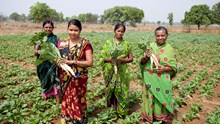
Many of us who live on the coast may have noticed weird, helmeted, long-tailed, crawling creatures on the beach during high tide. These are horseshoe crabs, commonly called ‘king crabs’ locally in some parts. Although the name is ‘crab,’ they are not actually crabs. They are more related to spiders and scorpions, as a matter of fact. Horseshoe crabs have existed for millions of years and have not changed much over all these years, which is why they are referred to as ‘living fossils.’
There are a total of only four horseshoe crab species in the entire world. Two of them—Tachypleus gigas and Carcinoscorpius rotundicauda—reside on India's eastern coast, predominantly in the states of Odisha, West Bengal, and Andhra Pradesh. They like to inhabit shallow waters with sandy or muddy bottoms and are largely mostly seen during spring tides when they move up onto the shore to breed.
Physical Appearance of Horseshoe Crabs
The horseshoe crab body is divided into three main parts. The front, or prosoma or head, resembles a horseshoe, and that is how they got this name. It is a shield-like part that covers the brain, heart, and eyes. Horseshoe crabs possess nine eyes and other light-sensitive organs, which help them in sensing light and movement, particularly during breeding season.
The middle section is the abdomen, which is covered with spines on the sides. These spines protect the crab from predators. They have gills and muscles underneath to breathe and move. The last part is the telson or tail, which is long and sharp. Most people believe this tail to be dangerous, but it's only used to help the crab in flipping itself over should it get turned over.
Interestingly, the female horseshoe crab is bigger than the male. The female can reach a length of 19 inches (approximately 48 cm), whereas the male is a bit smaller.
Life Cycle: A Journey from Egg to Adult
Horseshoe crabs come to the beach mostly during full moon and new moon nights in spring to lay eggs. This breeding season is crucial for coastal ecosystem health. One female deposits almost 90,000 eggs in the sand. These eggs are a major food source for numerous migratory birds, which travel thousands of kilometers to feed on them.
Within two to four weeks, the eggs hatch and develop into tiny baby crabs that resemble adults but without tails.
These young crabs swim about in the water for a couple of days and then settle down on the sea bottom. As they continue to grow, they molt many times their outer shell. They live in shallow waters as young ones and migrate gradually to deeper waters as they mature. Horseshoe crabs take their time growing and can live for more than 20 years.
Feeding Habit
Horseshoe crabs are bottom feeders. They feed on tiny animals living on the seafloor like worms, clams, and other small sea animals. Their function of cleaning the seafloor is quite crucial, similar to the way cows roam on a field to keep the grass under control.
Why Are Horseshoe Crabs Important?
These ancient creatures may not seem important at first glance, but they play several vital roles:
-
For Nature: Their eggs provide an important food source for birds on migration. Without their eggs, numerous species of birds would not survive on their long journey.
-
For Science and Health: Horseshoe crab blood, particularly that of the American variety, is used to ensure medicines and vaccines are pure. The blue-colored blood has a unique chemical that can identify harmful bacteria. Thanks to them, most of our medical injections and IV fluids are safe.
-
For Soil: In certain locations, dried crabs are employed in producing natural fertilizers as well as animal feed.
Although in India we do not collect horseshoe crabs for their blood or utilize them extensively in fisheries, their presence along our shores is still important. They help to keep our sea life healthy and in balance.
Threats They Face
Unfortunately, horseshoe crabs are under serious threat everywhere in the world. Their population is gradually reducing. Destruction of their natural habitats is one of the major threats they face. As more buildings, roads, and industries come up near the coasts, the sandy beaches and muddy flats where these crabs live and lay their eggs are getting damaged. Pollution by factories, sewage, and plastic waste further damages their ecosystem and makes their survival impossible.
Fishing activities also create a significant threat. Many horseshoe crabs accidentally become trapped in fishing nets, particularly when they are breeding and come closer to the shore. Once caught, most of them perish since they are unable to escape. In certain nations, individuals catch horseshoe crabs to consume them or use them to prepare traditional medicines, further putting pressure on their population.
Another major problem is the lack of awareness. Most of the local communities are unaware of the significance of horseshoe crabs in the coastal environment. Without this awareness, they unknowingly destroy the animals or their nesting sites. Although Indian coastal waters are relatively cleaner than other parts of the world, the increasing human activities like overfishing, beach development, and sand mining are worsening the fate of these marine animals that date back to millions of years.
How Can Farmers and Coastal Communities Help?
People who reside in coastal villages, particularly fishermen and farmers, can help contribute significantly towards the conservation of horseshoe crabs. Although These creatures may not directly give us food or income directly, they contribute to maintaining our coastal ecosystem in good health, thereby supporting fish, prawns, and other marine animals on which we rely.
When the breeding season comes, It is important we must not catch or touch the crabs when they emerge at the beach to lay eggs. If you notice a horseshoe crab that has been turned upside down, you can rescue it by turning it back using a stick and be very cautious not to pick it up by its tail, as that damages the crab.
It is also important to safeguard the sandy and muddy beaches where they deposit their eggs. Do not drive vehicles or dispose of garbage in such a place. Making other farmers, fishers, and community people aware of how valuable horseshoe crabs are can really help. It can create awareness and decrease the number of crabs being accidentally harmed.
If you happen to see numerous dead crabs, or witness them being caught in nets when breeding season arrives, then it would be best to alert nearby forest officials or marine authorities. They will be able to take appropriate action to secure the site and prevent further harm to the crabs.
Respect the Ancient Life of Our Shores
Although they don't provide us with milk or meat, horseshoe crabs are nature's protectors of our coastlines. We must take care of these ancient marine creature in the same way that farmers do with their land and livestock. We all gain from the coastal ecosystem's healthy balance, which is ensured by their survival. Our future is safeguarded when we preserve horseshoe crabs.
(Source: ICAR-NBFGR)
















